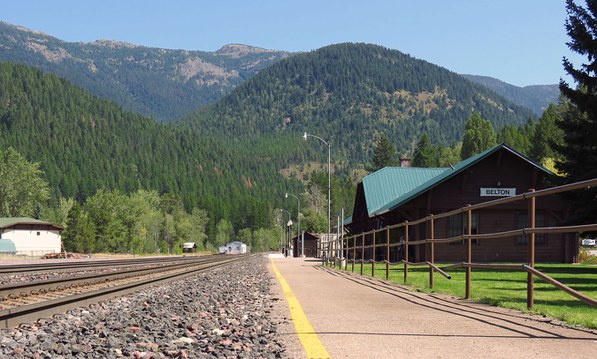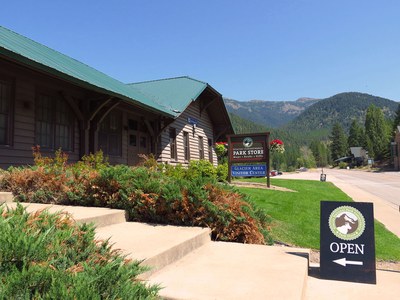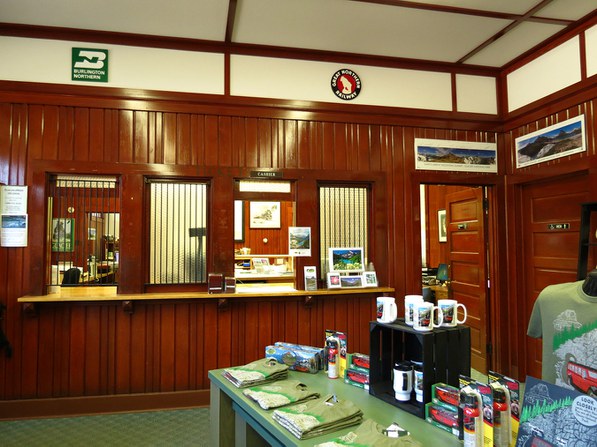The Great Northern Railway moved through northwestern Montana in 1891 as it worked to complete a transcontinental line between St. Paul, Minn., and Seattle. Tourism developed as word spread of the region’s natural beauty and abundant wildlife.

The West Glacier depot acts as a gateway to Glacier National Park for rail travelers.
In 1910, President William Howard Taft designated what is now Glacier National Park, whose lakes, forests, meadows and soaring mountains attracted more than 2.3 million visitors in 2014. About half of the more than 400 national park system units are easily accessible via Amtrak-served communities.

The Glacier National Park Conservancy uses the historic depot as a retail shop and office space.
To welcome visitors to the west side of the park, the Great Northern opened the present wood frame depot in 1910; it was later enlarged in 1935 with the older section becoming the baggage and express area. Rough-hewn siding extends over the entire structure and gives it a rustic appearance that blends well with other park structures. The center of the building features a clipped cross-gable. A trellised pathway originally connected the depot with the Belton Chalet, one in a series of resort hotels constructed by the Great Northern in and around the park.
West Glacier is one of five Amtrak stations that provide access to Glacier National Park. The others include Whitefish, Essex, East Glacier (open mid-spring to mid-fall) and Browning (open mid-fall to mid-spring).
Depot Adaptive Reuse
Today the West Glacier depot is owned by the Glacier National Park Conservancy, the park’s official nonprofit partner that provides support for preservation, education and research in Glacier through philanthropy and outreach. One of the conservancy’s predecessor organizations received the building as a donation from Burlington Northern Railroad (now part of BNSF) in 1991 and converted it into a retail shop.
“Amtrak’s an important link that allows people from across the country to access the wilderness resource right in our own backyard.”– Mark Preiss, Glacier National Park Conservancy CEO
Subsequent renovation projects, including the enclosure of a covered picnic area to create office space and a conference room, have been completed in a manner that complements and preserves existing historic fabric. The depot also houses the conservancy’s operations offices and merchandise storage area.
In the retail space, original wood paneling and the ticket counter form a suitable backdrop for displays of clothing, books and souvenirs. Revenue from the four stores operated by the conservancy supports vital programs at Glacier. “These efforts include funding for 8,000 school children to participate in field trips to the park each year, internships for future park rangers and critical mountain goat research,” says Mark Preiss, the conservancy’s chief executive officer.

The waiting room is now a popular gift shop; revenue supports vital programs at Glacier National Park.
The organization actively seeks grants to assist with building rehabilitation and maintenance to ensure that proceeds from store operations directly support the park and its programs. During the summer high season, approximately 200 people per day visit the depot; Amtrak passengers on the two daily trains use the adjacent platform. “Train service has historically connected visitors to Glacier National Park, back to the early days of the Great Northern Railroad,” notes Preiss.
Keys to Success
- Adaptive reuse ensured the depot would continue to welcome visitors throughout the year
- Underutilized space adaptively reused to house retail and office functions
- Successive renovations have maintained and preserved the depot’s historic fabric
Thank you to to Amy Dempster of the Glacier National Park Conservancy for her assistance. Images courtesy of the conservancy.



 Amtrak established the Great American Stations Project in 2006 to educate communities on the benefits of redeveloping train stations, offer tools to community leaders to preserve their stations, and provide the appropriate Amtrak resources.
Amtrak established the Great American Stations Project in 2006 to educate communities on the benefits of redeveloping train stations, offer tools to community leaders to preserve their stations, and provide the appropriate Amtrak resources. Amtrak is seizing a once-in-a-lifetime opportunity to transform rail and Retrain Travel. By modernizing, enhancing and expanding trains, stations and infrastructure, Amtrak is meeting the rising demand for train travel. Amtrak offers unforgettable experiences to more than 500 destinations across 46 states and parts of Canada. Learn more at
Amtrak is seizing a once-in-a-lifetime opportunity to transform rail and Retrain Travel. By modernizing, enhancing and expanding trains, stations and infrastructure, Amtrak is meeting the rising demand for train travel. Amtrak offers unforgettable experiences to more than 500 destinations across 46 states and parts of Canada. Learn more at